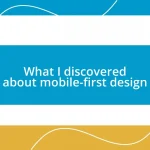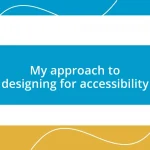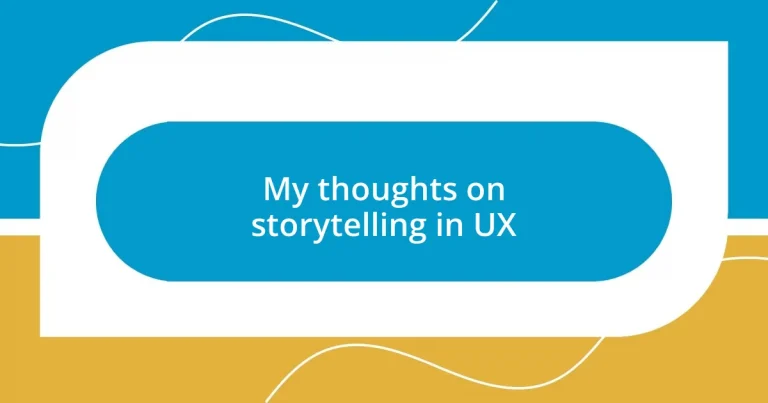Key takeaways:
- Storytelling in UX humanizes the user experience, creating emotional connections that enhance empathy and relatability.
- Key elements of effective storytelling include relatable characters, a clear emotional arc, and visual storytelling techniques that engage users.
- Successful case studies, like Airbnb and Nike, illustrate the power of personal narratives in elevating brand identity and user engagement.
- Tools such as storyboarding, prototyping, and data storytelling help visualize and communicate the user journey effectively.

Understanding storytelling in UX
Storytelling in UX is not just about weaving narratives; it’s about creating connections. I remember designing a project where I interviewed users, and their anecdotes about frustration and joy became my guiding light. Isn’t it fascinating how a single story can illuminate the path forward in design?
At its core, storytelling helps to humanize the user experience. When I craft a user journey, I often ask myself: What emotions drive my users’ actions? By understanding these emotions, I can create a more engaging and empathetic design that resonates deeply with users.
When designers incorporate storytelling, they turn data into a narrative that speaks directly to the user’s heart and mind. In one project, I transformed raw analytics into a story about a user’s journey, which helped my team realize the importance of empathy in product design. Have you ever thought about how the simplest stories can evoke profound user engagement?
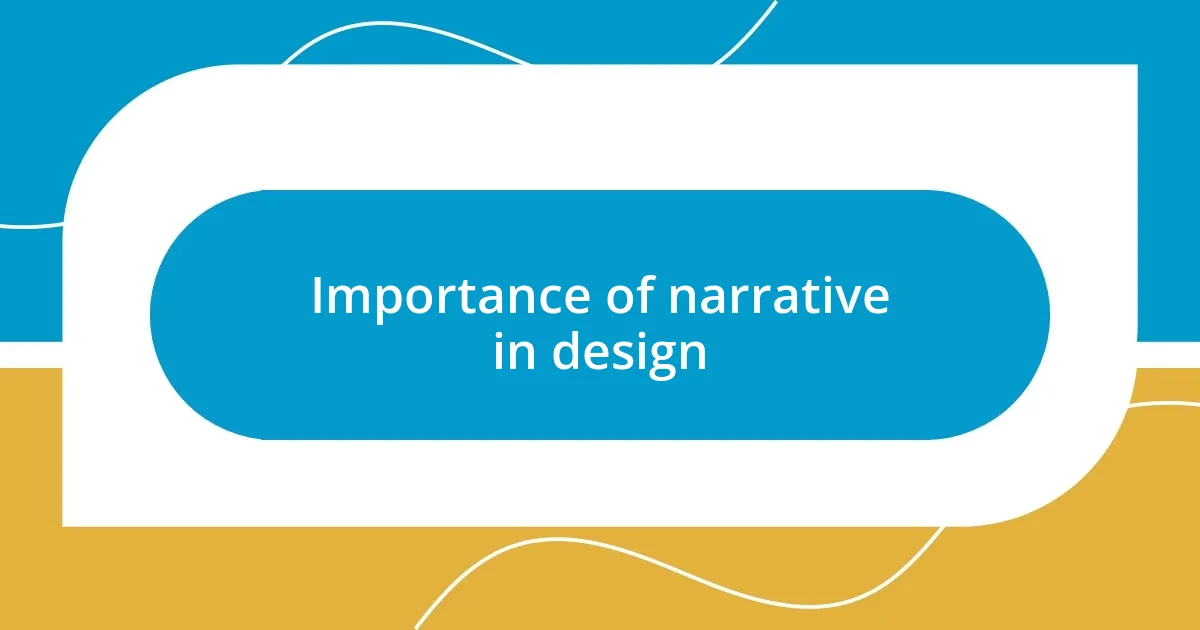
Importance of narrative in design
The narrative in design is crucial because it serves as a bridge between the user and the product. I recall a project where I used storytelling to craft a compelling brand narrative that not only showcased the features but also highlighted the deeper purpose behind the product. This approach made it easier for users to relate, fostering a connection that numbers alone couldn’t achieve.
Through effective narratives, designers can guide users through their experience, almost like telling them a story where they are the protagonists. I particularly enjoyed crafting micro-interactions that felt like snippets of a larger story, enabling users to feel a sense of progression and achievement. As a result, every click became a new chapter, making the journey feel seamless and engaging.
Moreover, a strong narrative can enhance memorability. In my experience, when I integrated storytelling into training sessions, participants retained information better than ever before, as they could relate to the relatable scenarios I presented. Think about it: don’t you often remember stories far more vividly than data points?
| Aspect | Importance of Narrative |
|---|---|
| User Connection | Creates empathy and relatability between the user and the product |
| Guiding Experience | Steers users through their journey, making them feel part of the story |
| Memorability | Makes information more memorable through relatable scenarios |
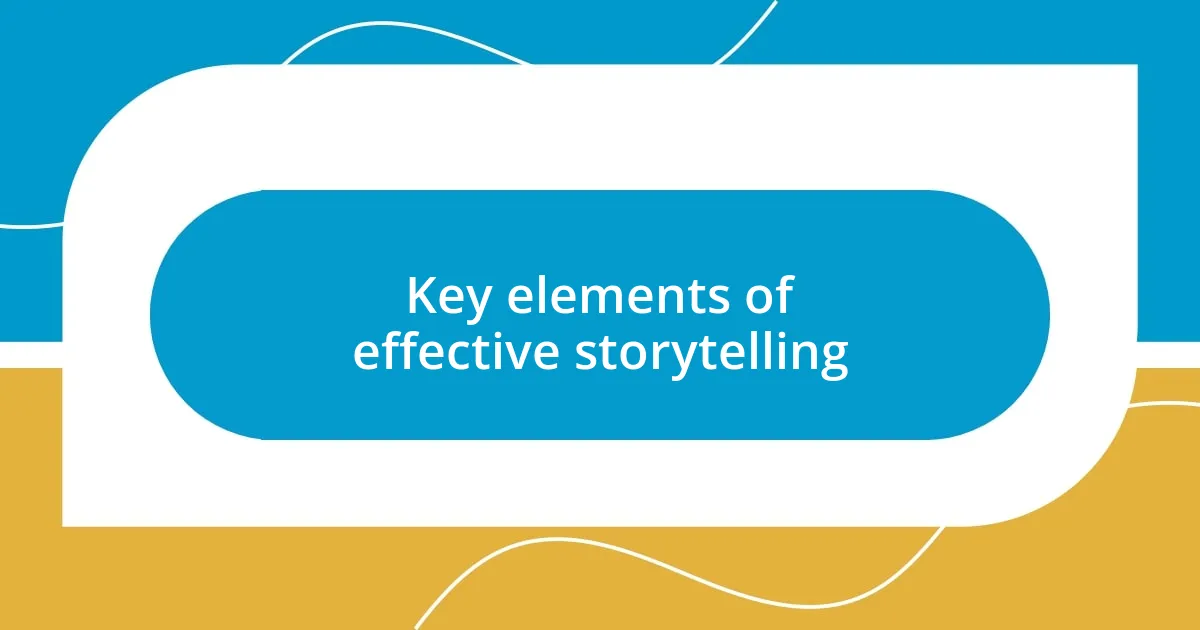
Key elements of effective storytelling
Effective storytelling in UX requires a blend of relatable characters and a journey that users can identify with. I once created a persona-based narrative that followed a user through the ups and downs of their daily tasks. The emotional highs and lows of that journey resonated with my audience, transforming them from mere observers to active participants in the narrative. When users see themselves represented in a story, it fosters a connection that purely functional design cannot achieve.
Here are the key elements I believe contribute to effective storytelling in UX:
– Relatable Characters: Users connect better with stories that include characters they can identify with, reflecting their experiences and challenges.
– Emotional Arc: A well-defined emotional journey ensures that users engage with the narrative on a personal level, making them invested in the outcome.
– Clear Structure: A beginning, middle, and end structure provides a familiar framework that guides users through the experience, enhancing understanding and retention.
– Conflict and Resolution: Introducing a challenge for the user adds depth, making the eventual resolution rewarding and memorable.
– Visual Storytelling: Integrating visuals helps illustrate the narrative, making it more engaging and easier for users to grasp complex ideas quickly.
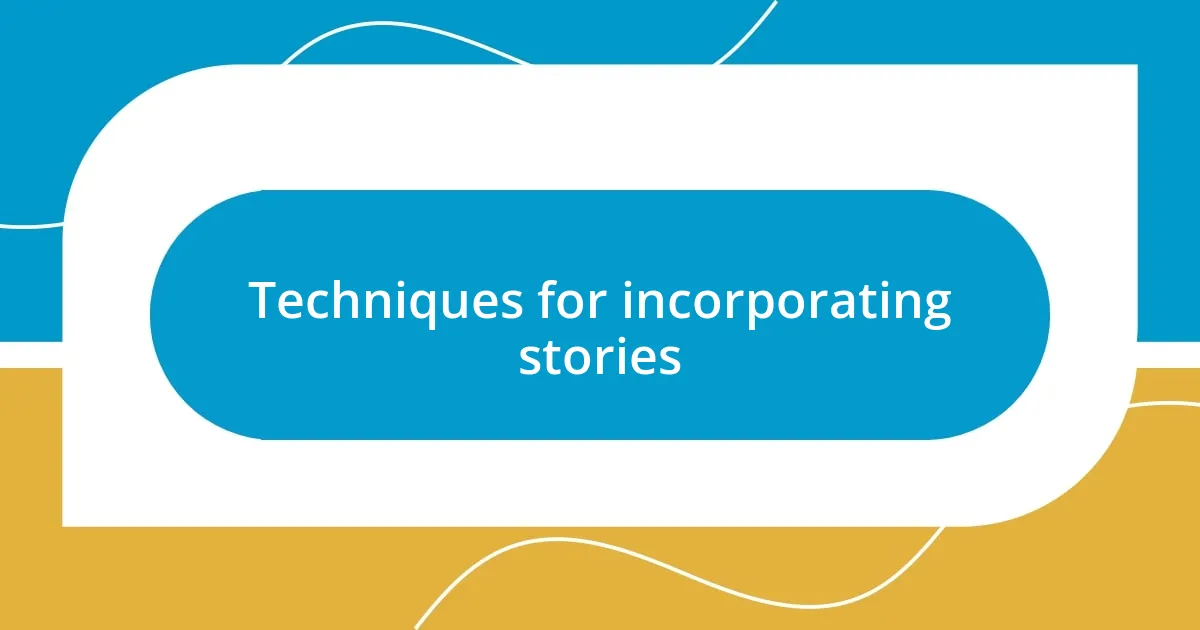
Techniques for incorporating stories
One effective technique is to use visual storytelling to capture attention and foster engagement. I remember a project where I crafted a series of infographics to narrate the user journey. Each visual stood out as a chapter that depicted a real-life scenario, which not only made the information digestible but also emotionally resonant with the audience. Have you ever noticed how a compelling image can speak volumes in a matter of seconds? It’s a powerful tool that enhances understanding almost instantly.
Another approach I found valuable is persona development, where I create detailed character profiles that embody the target audience. In one instance, I designed a narrative around a fictional user who faced common challenges that our actual users encountered. This exercise allowed my team to visualize the user’s journey vividly. When we discussed the persona’s emotions, fears, and triumphs, it sparked discussions that directly influenced our design choices. Isn’t it fascinating how putting a face to user data can breathe new life into collaboration?
Lastly, incorporating micro-interactions into the design serves as subtle storytelling cues that keep the user engaged. I strive to make every feedback moment a mini-story, like a well-timed animation that elicits joy or surprise. I once implemented a playful loading animation that felt like a quick quest, and users responded positively, appreciating the interactive nature during wait times. These small narratives in interactions remind us that every aspect of the user experience holds the power to tell a story. How do you think your users would feel about these interactive moments?
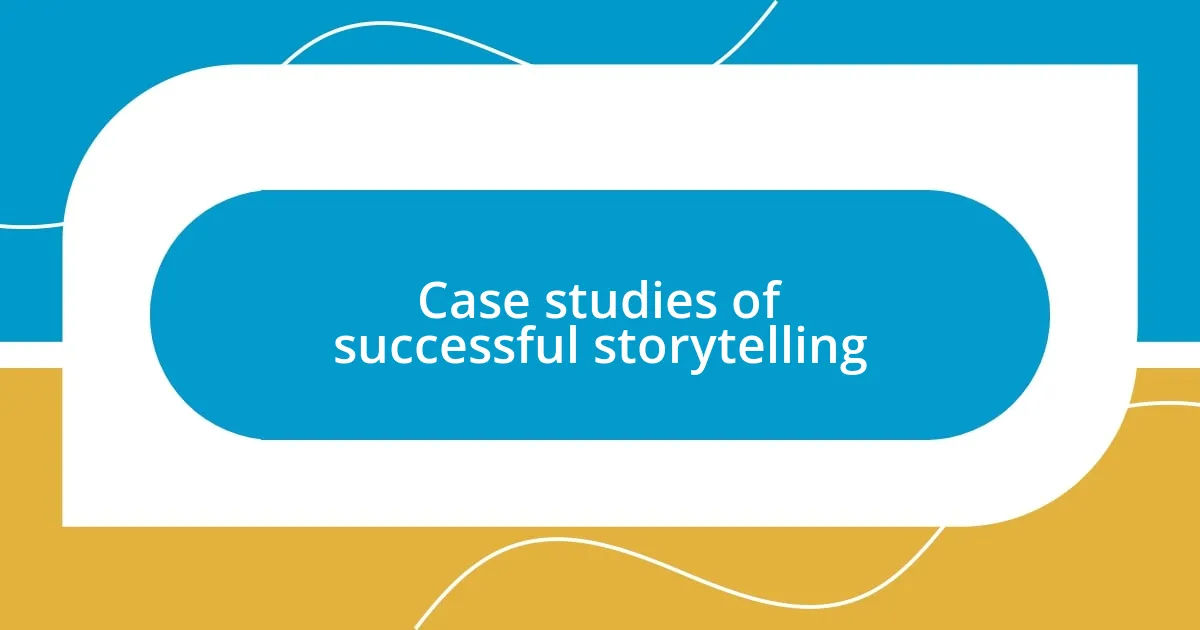
Case studies of successful storytelling
In my experience, one case that stands out is Airbnb’s “Stories from the Frontline” campaign. By showcasing real stories from hosts and guests, they created an emotional connection that transformed the way users viewed their platform. I remember the first time I saw the heartfelt narratives—they drew me in completely, making me not just a user, but someone who wanted to be part of shared, authentic experiences. Doesn’t it make you reconsider how personal stories can elevate a brand’s identity?
Another great example is Nike’s “Find Your Greatness” campaign, which emphasizes personal journeys rather than just the products. I was particularly moved by the story of an everyday athlete—a young boy who trained to run a marathon. His struggles and triumphs resonated with me, reminding me of my own fitness challenges. This approach tap into something deeply human—motivation and perseverance—and it struck a chord. Can you think of a time when a brand’s story inspired you more than the product itself?
Lastly, I’d point to Slack’s user-centric narrative design. Their onboarding process incorporates real user stories, which helps new users relate to the experience. I once navigated their platform and was pleasantly surprised by how relatable the scenarios felt, making me instantly comfortable. It was almost as if I was stepping into a community that understood my needs. Isn’t it fascinating how storytelling in UX not only informs but also invites users to be part of a larger narrative?
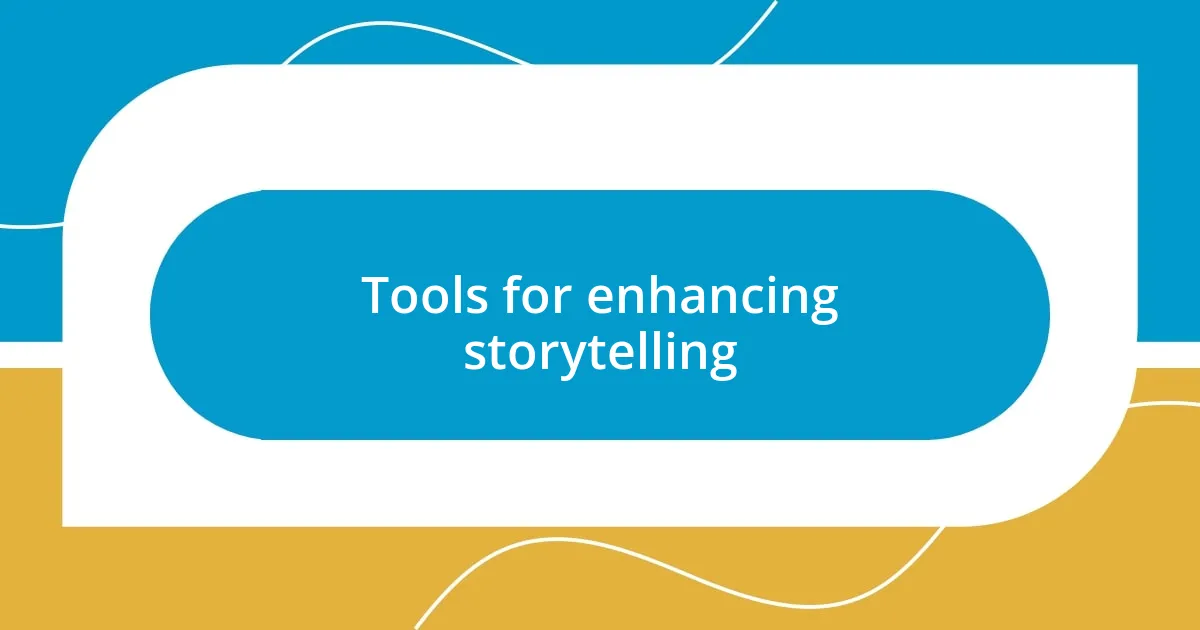
Tools for enhancing storytelling
When it comes to enhancing storytelling in UX, one of my favorite tools has been storyboarding. Storyboards allow me to visualize the user journey in a sequence of frames, almost like comic strips for our design ideas. I vividly remember using this method for a project where we needed to illustrate a complex process. Seeing everything laid out helped the team identify gaps in our narrative and find those moments that really needed emotional punch. Have you ever considered how much clarity a simple illustration can bring to your design discussions?
Another powerful tool is prototyping. Through prototyping, I can create interactive experiences that allow users to immerse themselves in the story firsthand. In one recent project, I crafted a clickable prototype that led users through a day in the life of a character I had developed. Watching users navigate this prototype and react to the unfolding narrative was like sharing a secret with them, transforming our insights into shared experiences. Don’t you think this kind of interaction can deepen user empathy and connection?
Let’s not forget the importance of data storytelling. I often analyze user research data and present it in a narrative format, weaving statistics and findings into a compelling story. I remember delivering a presentation that turned raw user feedback into a narrative arc illustrating pain points and user aspirations. The impact was palpable—my audience leaned in, resonating with the data on an emotional level. How do you think your stakeholders would react if data were presented not just as numbers, but as stories that they could feel and connect with?


